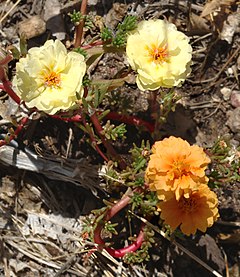基因突變
閱讀設定
(由基因變異跳轉過嚟)


基因突變(genetic mutation)係細胞入面嘅遺傳基因出現咗變化,原因可以係細胞分裂嗰陣複製基因出錯,又或者受到輻射同化合物等外界嘢影響。基因突變嘅結果會令細胞同正常唔同,結果可以係壞(傷害隻生物),亦可以係好(對隻生物有利)。
DNA 上好多時會有複製咗幾次嘅基因,而呢啲「多咗幾份出嚟」嘅基因被指係有利於突變嘅發生[1][2]:喺好多生物物種嘅 DNA 當中都會有「做同一樣功能嘅基因多咗幾份」嘅情況,例例如係喺人 DNA 負責整眼珠嘅基因當中,有 4 個基因係用嚟整感光結構嘅,而有 3 個基因整視錐細胞同 1 個基因整視桿細胞,而呢柞基因本來都係由一個基因演變出嚟嘅[3];想像家陣有個基因因為突變而壞咗,做唔到佢原有嘅功能,但條 DNA 上有呢個基因嘅複製品,噉啲複製品就可以做埋嗰個基因嗰份,等隻生物唔會因為突變搞到佢做唔到某啲對生存繁殖嚟講必要嘅功能-「一個基因多咗幾份」可以間接令「靠突變嚟進化」呢家嘢對個體以至成個物種嚟講風險冇咁高[4][5]。除此之外,第啲類型嘅突變仲可以由本來冇用嘅 DNA 嗰度變啲全新嘅基因出嚟[6][7]。
睇埋
[編輯]攷
[編輯]- ↑ Hastings, P. J.; Lupski, James R.; Rosenberg, Susan M.; Ira, Grzegorz (August 2009). "Mechanisms of change in gene copy number". Nature Reviews Genetics. London: Nature Publishing Group. 10 (8): 551–564.
- ↑ Harrison, Paul M.; Gerstein, Mark (May 17, 2002). "Studying Genomes Through the Aeons: Protein Families, Pseudogenes and Proteome Evolution". Journal of Molecular Biology. Amsterdam, the Netherlands: Elsevier. 318 (5): 1155–1174.
- ↑ Bowmaker, James K. (May 1998). "Evolution of colour vision in vertebrates". Eye. London: Nature Publishing Group on behalf of the Royal College of Ophthalmologists. 12 (3b): 541–547.
- ↑ Gregory, T. Ryan; Hebert, Paul D. N. (April 1999). "The Modulation of DNA Content: Proximate Causes and Ultimate Consequences". Genome Research. Cold Spring Harbor, NY: Cold Spring Harbor Laboratory Press. 9 (4): 317–324.
- ↑ Hurles, Matthew (July 13, 2004). "Gene Duplication: The Genomic Trade in Spare Parts". PLOS Biology. San Francisco, CA: Public Library of Science. 2 (7): e206.
- ↑ Liu, Na; Okamura, Katsutomo; Tyler, David M.; et al. (October 2008). "The evolution and functional diversification of animal microRNA genes". Cell Research. London: Nature Publishing Group on behalf of the Shanghai Institutes for Biological Sciences. 18 (10): 985–996.
- ↑ Siepel, Adam (October 2009). "Darwinian alchemy: Human genes from noncoding DNA". Genome Research. Cold Spring Harbor, NY: Cold Spring Harbor Laboratory Press. 19 (10): 1693–1695.
